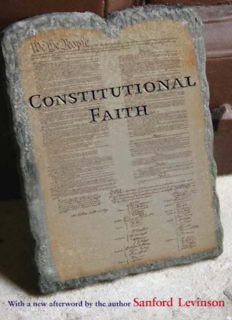
Constitutional Faith PDF
Preview Constitutional Faith
V лП 'П % Sanford Levinson afterword by the author CONSTITUTIONAL FAITH S ANF ORD LEVI NSON Constitutional Faith With a new afterword by the author PRINCETON UNIVERSITY PRESS PRINCETON AND OXFORD Copyright © 1988 by Princeton University Press Published by Princeton University Press, 41 William Street, Princeton, New Jersey 08540 In the United Kingdom: Princeton University Press, 6 Oxford Street, Woodstock, Oxfordshire OX20 1TW press.princeton.edu All Rights Reserved First printing, 1988 First paperback printing, 1990 Paperback reissue, with a new afterword, 2011 Library of Congress Control Number: 2011925345 ISBN: 978-0-691-15240-0 British Library Cataloging-in-Publication Data is available This book has been composed in Linotron Caledonia Printed on acid-free paper. ∞ Printed in the United States of America Illustrations by Zevi Blum 1 3 5 7 9 10 8 6 4 2 To Cynthia, for everything (1987) To Cynthia, for so much more than I ever imagined (2011) This page intentionally left blank C O N T E N T S ACKNOWLEDGMENTS IX INTRODUCTION 3 CHAPTER ONE The “Constitution” in American Civil Religion 9 CHAPTER TWO The Moral Dimension of Constitutional Faith 54 CHAPTER THREE Loyalty Oaths: The Creedal Affirmations of Constitutional Faith 90 CHAPTER FOUR Constitutional “Attachment”: Identifying the Content of One’s Commitment 122 CHAPTER FIVE The Law School, the Faith Community, and the Professing of Law 155 CHAPTER six Conclusion: Adding One’s Signature to the Constitution 180 NOTES 195 AFTERWORD TO THE 2011 EDITION 245 INDEX 257 - vii - This page intentionally left blank A C K N O W L E D G M E N T S Over the many years during which this book was gestating, one of the incentives for its completion was the opportunity I would then have to write an acknowledgments page that would convey my thanks for help to an ever-increasing number of friends and associates. Now the time has come, and I want to take full advantage of that opportu nity. With completion has come as well chastening knowledge of the reality undergirding what had, as I read other writers' acknowledg ments, always seemed to me the cliche that those acknowledged were not responsible for any remaining weaknesses. Along with advice gratefully accepted there remain other suggestions that were un wisely rejected. (The problem, of course, is that I am not wise enough to know which of the rejected suggestions are in that category.) In any event, I am immensely grateful both for the opportunity to work with these many individuals and to the institutions that provided the set ting for collaboration. I begin with the institution that most directly contributed to my completing this work, the Institute for Advanced Study in Princeton, New Jersey, which honored me with membership, half of which was funded by the National Endowment for the Humanities, during 1986- 87. The remaining funding came from the University Research Insti tute of the University of Texas. Without denigrating the importance of the funding, I want to register special gratitude for the almost lit erally incredible work environment provided at the Institute for Ad vanced Study; it made the writing of this manuscript a joy. In addition to the institution, I am grateful to several of its members, including Elizabeth Hill Boone, William Connolly, Clifford Geertz, Albert Hirschman, Joan Scott, and Barbara Herrnstein Smith, all of whom read drafts of chapters and discussed them with me. Encouraging words from Carl Schorske and Barbara and Dennis Tedlock early in the year were much appreciated. One member of the Institute, Michael Walzer, deserves separate mention. He could be listed under almost all of the institutional ref erences to follow: I first met him at Harvard; it was as a teaching fellow in his course at Harvard that I first became obsessed by the problem of pluralism, which in this book is the focus of Chapter - ix -
Description: